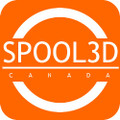Filament Printers
- Product
- Qty in Cart
- Quantity
- Price
- Subtotal
-

Creatbot D600 Pro Industrial Professional 3D Printer
Creatbot
$13,999.00Free shipping in Canada for orders over $140 before tax. (via Canada Post) Lead time is approximately 3-4 weeks. Large Build VolumeD600 Pro print size 600*600*600mm. Nozzle Temprature Up To 420 ℃The D600 Pro is equipped with the 4th generation 1.75mm...$13,999.00 -

Creatbot PEEK-300 3D Printer
Creatbot
$17,999.00Free shipping in Canada for orders over $140 before tax. (via Canada Post) CreatBot PEEK-300 is an industrial grade 3D printer, focusing on high performance materials such as PEEK, PEKK, PEI (Ultem), etc. It is designed for high reliability and...$17,999.00
FDM (Fused Deposition Modeling)
How It Works:
FDM is a widely used 3D printing technology that builds objects layer by layer by extruding a thermoplastic filament through a heated nozzle. The material cools and solidifies quickly as it is deposited onto the print bed, creating each layer of the model.
Materials:
- Filaments: Commonly used materials include PLA (Polylactic Acid), ABS (Acrylonitrile Butadiene Styrene), PETG (Polyethylene Terephthalate Glycol), TPU (Thermoplastic Polyurethane), and more.
- Characteristics: These materials come in various colors and properties, offering options for strength, flexibility, and ease of use.
Advantages:
- Affordability: FDM printers are generally more affordable and accessible, making them popular for both hobbyists and professionals.
- Material Variety: A wide range of filament types and brands are available, allowing for customization based on the application.
- Ease of Use: FDM technology is relatively straightforward and user-friendly, with many printers offering plug-and-play functionality.
Disadvantages:
- Layer Lines: Prints can have visible layer lines, which may require post-processing for a smoother finish.
- Resolution: FDM printers typically have lower resolution compared to resin and SLS printers, which can impact detail and surface quality.
Applications:
- Prototyping: Ideal for creating functional prototypes and concept models.
- Hobby and Home Use: Suitable for DIY projects, educational purposes, and small-scale manufacturing.
